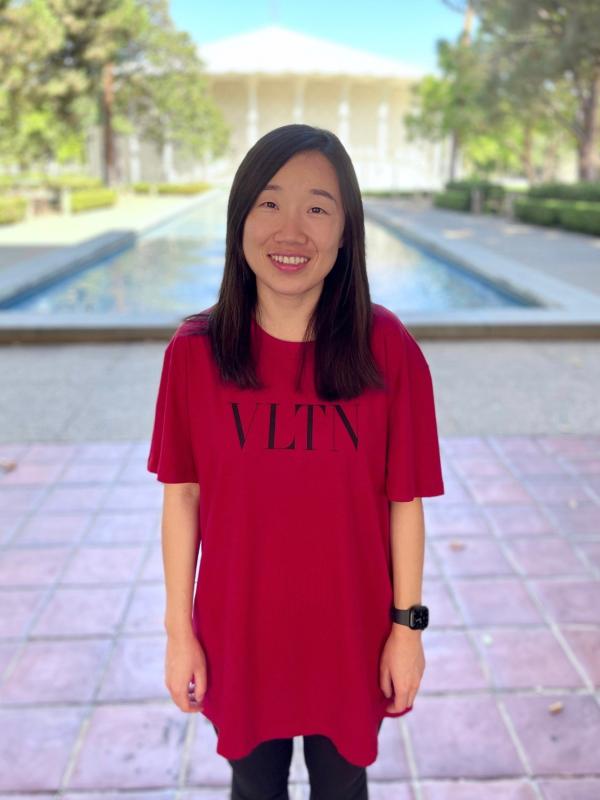Chengcheng Fan wins 2022 Klein Award for coronavirus vaccine and protein transporter research
Fan’s X-ray crystallography work at SLAC’s synchrotron moves us closer to a more protective coronavirus vaccine and a better understanding of how vital materials flow in and out of cells.
By David Krause
Chengcheng Fan is not sure what she will be doing twenty years from now. But later in life, she wants to look back and say that she tried her hardest to help develop a more powerful coronavirus vaccine during the global pandemic.
So far, Fan is doing just that: She has mapped the structures of more than 30 antibodies attached to coronavirus spike proteins using cryo-electron microscopes at the California Institute of Technology (Caltech) Cryo-EM Center and high-energy X-rays from the Stanford Synchrotron Radiation Lightsource (SSRL) at the Department of Energy’s SLAC National Accelerator Laboratory. Seeing antibodies bound to spike proteins is a key step in creating vaccines that can protect against a wider spectrum of coronavirus variants.
For her work, Fan will receive the prestigious Melvin P. Klein Scientific Development Award during SLAC’s Linac Coherent Light Source and SSRL Annual Users' Meeting and Workshops from Sept. 26 – 30.
Chengcheng Fan
Chengcheng Fan has won the prestigious Melvin P. Klein Scientific Development Award. (Kim Dam)

“Fan has changed the way we think about antibody recognition of coronavirus spikes,” Pamela J. Bjorkman, Caltech professor of biology and biological engineering, and Fan’s postdoctoral advisor, said. “Her studies have resulted in valuable knowledge in further developing our lab’s mosaic nanoparticle vaccine approach.”
Observing antibodies that are bound to spike proteins will help researchers identify what are called conserved locations on the virus spike protein. Conserved locations are the spots that look the same from one coronavirus type to the next – i.e., from a spike protein site on the original SARS-CoV-2 virus to one on the Omicron variant. If antibodies can’t recognize and bind to spike proteins, they can’t do their job of neutralizing the virus.
“Seeing these conserved locations is a big step towards developing a universal vaccine,” Fan said. “Without beam time at SSRL, we couldn’t have collected the diffraction data we needed to see the antibody structures and binding locations on the spike.”
Prior to researching coronavirus vaccines, Fan worked as graduate student at Caltech, where she helped determine the structures and functions of ABC transporters, which help nutrients and other substances flow across a cell’s membrane. To see the ABC transporter proteins, Fan fired SSRL’s X-rays onto crystallized protein samples, revealing their atomic structures.
“We took snapshots of the proteins at different positions to see the incredible transport process in action,” Fan said. “I don’t think we could have accomplished this project without SSRL’s macromolecular crystallography beam line.”
Fan became a virtuoso at crystallographic data collection and refinement over the years at SSRL, her graduate advisor and Caltech professor of chemistry, Douglas Rees, said.
“She has a remarkable combination of aptitude for structural biology and enthusiasm for synchrotron facilities that is a joy to experience,” Rees said.
In addition to being an incredibly productive structural biologist, Chengcheng finds the time to teach others the fundamentals of X-ray crystallography and cryo-EM, Bjorkman said.
Whatever she ends up doing in her career, she wants to contribute as much as possible now to coronavirus research.
“When I am 80, I want to say that back then I did something that was for good,” Fan said.
Each year since 2006, SSRL leadership presents an undergraduate, graduate student or postdoc with the Klein Award for outstanding research conducted at the facility. Melvin Klein was a renowned biophysicist at the Lawrence Berkeley National Laboratory and the University of California Berkeley, who applied experimental techniques to biological problems. He was a long time user of extended X-ray absorption fine structure methods at SSRL, and he devised this fluorescence detection technique for his group’s dilute samples.
SSRL is a DOE Office of Science User Facility. The SSRL Structural Molecular Biology program is supported by the DOE Office of Biological and Environmental Research and the NIH National Institute of General Medical Sciences.
For questions or comments, contact the SLAC Office of Communications at communications@slac.stanford.edu.
SLAC is a vibrant multiprogram laboratory that explores how the universe works at the biggest, smallest and fastest scales and invents powerful tools used by scientists around the globe. With research spanning particle physics, astrophysics and cosmology, materials, chemistry, bio- and energy sciences and scientific computing, we help solve real-world problems and advance the interests of the nation.
SLAC is operated by Stanford University for the U.S. Department of Energy’s Office of Science. The Office of Science is the single largest supporter of basic research in the physical sciences in the United States and is working to address some of the most pressing challenges of our time.




